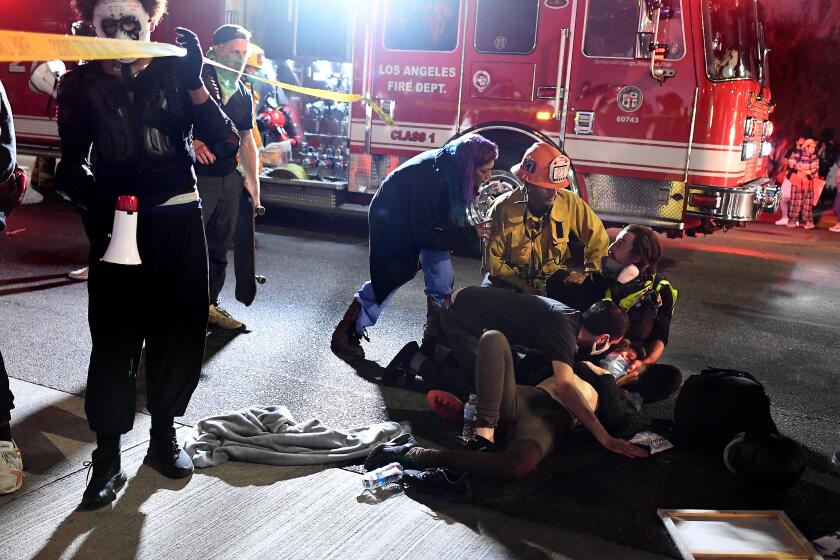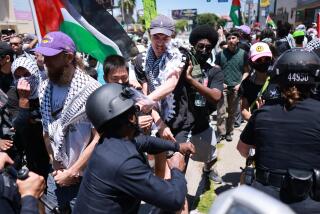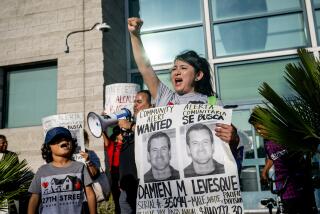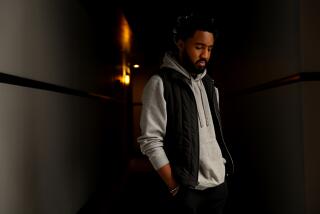Protests become a ‘lifestyle’ for some L.A. activists: ‘This has been like church for me’
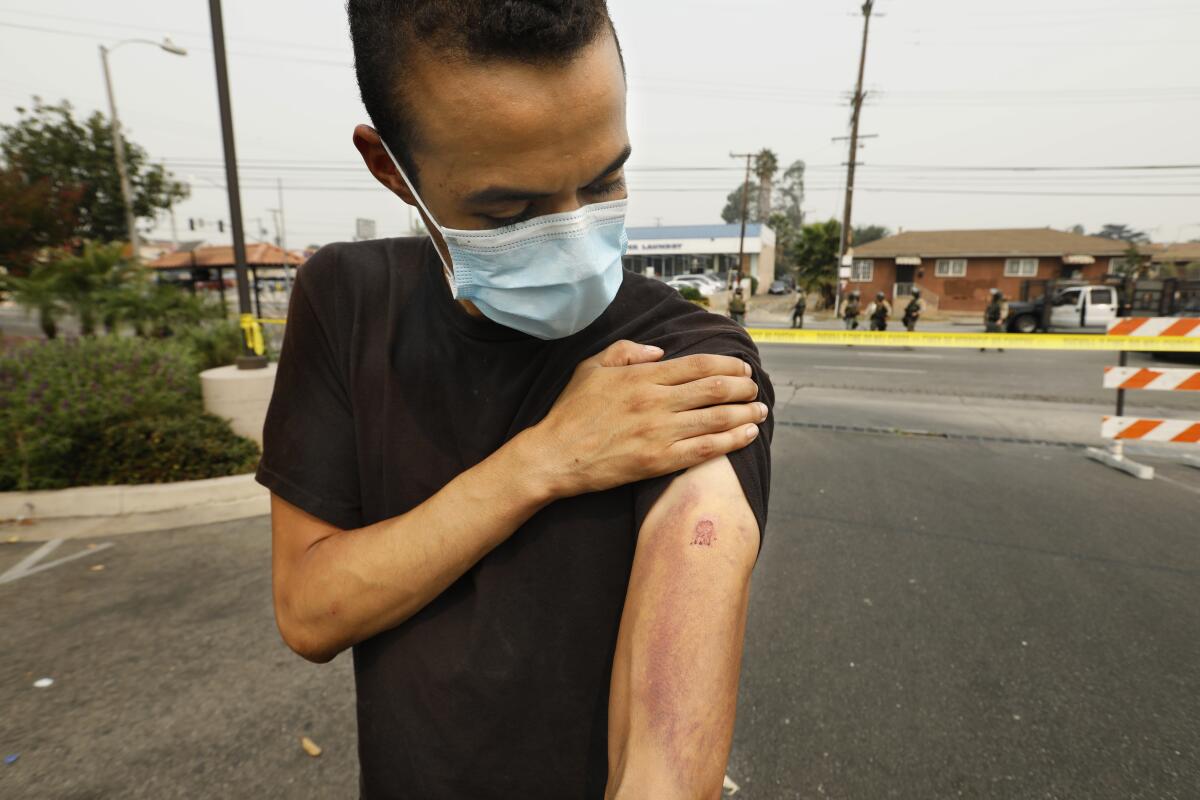
Matthew Sanders had a broken rib and dried blood on his face when he was released from jail Sept. 9 after being arrested on suspicion of failure to disperse during a protest. For a moment, he questioned whether he could continue showing up at the demonstrations outside the South Los Angeles sheriff’s station.
“I felt physically defeated,” he said.
The massive nationwide protests following the killing of George Floyd in Minneapolis police custody had launched Sanders, 30, into social action. He spent the summer bouncing between his full-time sales job and rallies in L.A. County against police shootings of people of color.
He has found a community of like-minded people who’ve made attending protests part of a weekly routine, in a wave of activism against police brutality that has continued into the fall in L.A. and across the country.
“I think it’s become part of a lifestyle for many people who have lost employment or who are working the gig economy,” said Shannon Thomas, 28, a conflict resolution consultant who has driven to the South L.A. protests from Santa Monica. “If we’re working 24/7 on our computers, what are we going to do that feeds our souls? This has been like church for me.”
Protesters took to the streets in Louisville, Ky., and Los Angeles after a grand jury declined to charge officers in the killing of Breonna Taylor.
As social activism has risen in the four months since Floyd’s death, some demonstrations have been met with increased police use of tear gas, projectiles and other force, fueling more anger and resistance, many in the protest movement said. Unrest erupted in Portland, Ore., during clashes with federal agents, in Kenosha, Wis., after the shooting of Jacob Blake, and in Louisville, Ky., after a grand jury declined to charge officers in the killing of Breonna Taylor.
Protests have also turned into polarizing political events. President Trump has castigated protesters as lawless and violent. After a handful of protesters shouted epithets outside a hospital where two Los Angeles County sheriff’s deputies were receiving treatment after being attacked by a gunman, a video of them went viral, becoming a rallying cry for critics.
In South L.A., protests in front of the sheriff’s station condemning the Aug. 31 deputy shooting of Dijon Kizzee in nearby Westmont have galvanized hundreds of people for weeks.
The protests have been largely peaceful. But the Sheriff’s Department regularly blocks off the entire street in front of the station during rallies while deputies in riot gear patrol crowds.
After a series of protests over Labor Day weekend, the department cast nighttime demonstrators as “rebellious, self-proclaimed anarchists” who are “clad for battle” and have alarmed locals, alleging that they’ve thrown “frozen water bottles, fireworks, smoke bombs, glass bottles, metal pipes, and chunks of cement to create chaos, damage and injury.”
However, of the dozens arrested around that time, virtually all were detained on suspicion of failure to disperse, rather than more serious offenses.
Sheriff Alex Villanueva denounced those protesters as being from disruptive groups that are “definitely not from this community.”
But those who have tapped into a new zeal for dissent say they march with the support of the neighborhood and of families who have lost loved ones to police shootings.
“I feel if we don’t do something about it now, nothing’s going to change,” said Demetra Johnson, whose son Anthony Weber was fatally shot by a deputy in Westmont at age 16. “I still have a 14-year-old son that’s got to grow up in this neighborhood.”
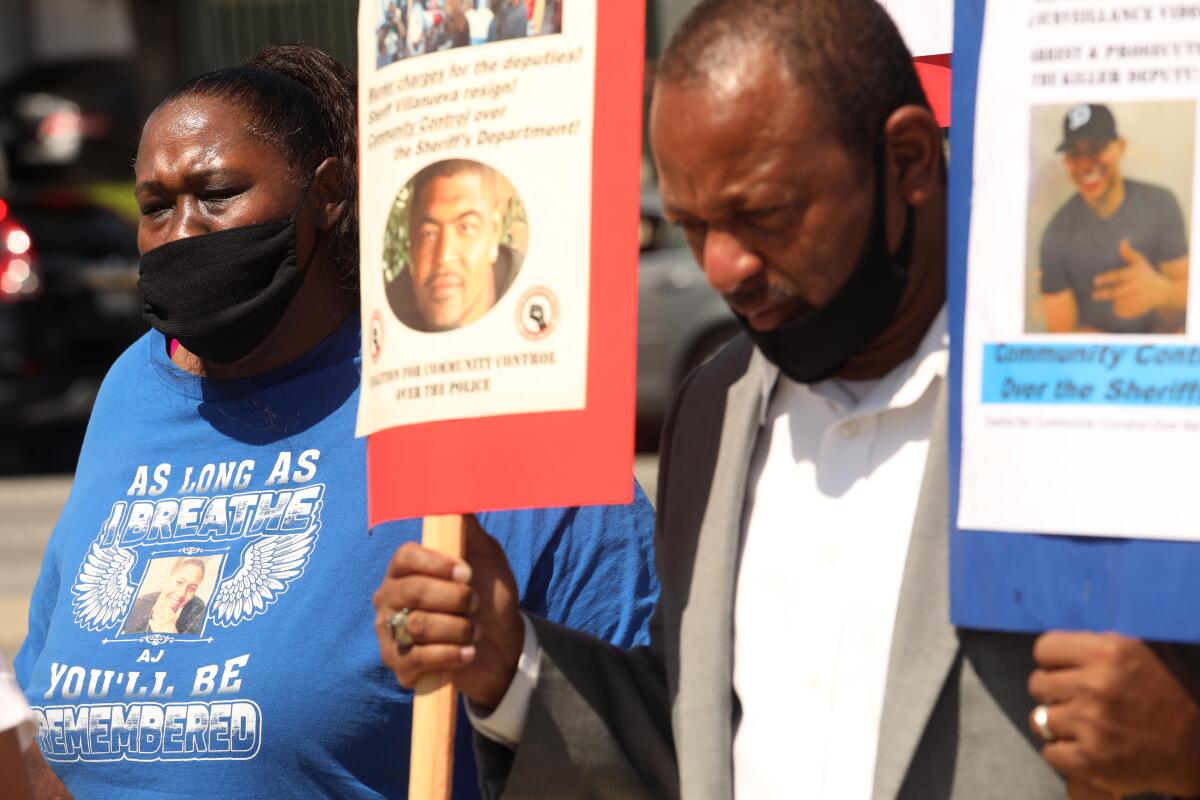
Some protesters said they have equipped themselves with helmets, cardboard shields and goggles because deputies have used unwarranted, aggressive tactics, a claim the department denies.
At recent protests outside the South L.A. station, Sanders saw new friends get hit by projectiles and tear gas fired by deputies in riot gear. He said he was tackled and punched multiple times by a deputy without provocation the night he was arrested.
Austin Baffa, 27, a freelance videographer from Orange County, said that during more than a week of protests at the station, he observed a few instances in which water bottles and a fireworks device were thrown by people in the crowd. He’s noted several people who he said came to the protests “just looking for a fight” by taunting deputies to shoot them. But that’s out of hundreds of others who were not combative.
“The outside agitator narrative just doesn’t seem to fit what I saw from the families’ support for people coming and protesting peacefully,” he said.
Plaintiffs in a class-action lawsuit allege that the Sheriff’s Department has improperly used force to disperse crowds without giving those present enough time to obey orders, saying deputies used projectiles, tear gas and other chemical agents indiscriminately against peaceful protesters, journalists and legal observers.
The department has said that deputies used so-called less-lethal force in response to protesters who threw rocks and bottles at officials, and not to cause them to disperse.
The injuries have not deterred Sanders.
“I’m Black and Hispanic, and this feels like my fight and what I’m supposed to be doing,” said the North Hollywood resident. “I feel compelled to this and to keep going if I can bring change so the next generation doesn’t grow up in fear of the cops.”
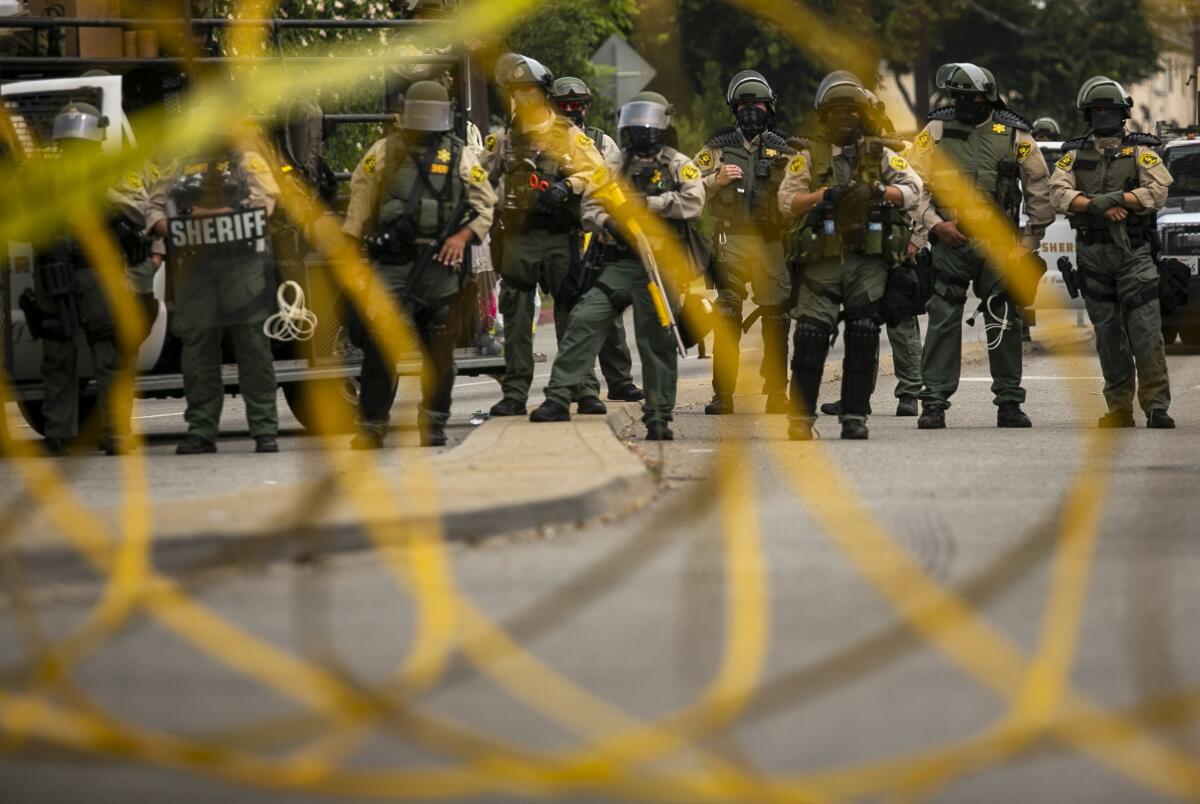
The Sheriff’s Department has said that Kizzee was riding his bike on the wrong side of the street when he was stopped by two deputies. A pursuit ensued, ending with the deputies firing 19 shots at him. Officials said Kizzee pointed a gun at deputies, but an attorney for Kizzee’s family said witnesses didn’t see anything in his hands.
Fernando Guerra, director of the Center for the Study of Los Angeles at Loyola Marymount University, said the subsequent weeks-long sustained protest movement is historic.
“One of the most difficult things to do is to mobilize people, to get people to physically take action, to get people to take time out of the day,” he said.
Attempts to delegitimize protests may also help mobilize people, he said.
Many attending marches at the South L.A. sheriff’s station have became regulars.

That’s the case for Jessica Rogers of North Hollywood, who was moved by the Floyd protests and now attends every action she can, quick to acknowledge privileges she has as a white woman.
Rogers, 30, drove to Palmdale nearly every day to demand answers when a Black man was found hanging from a tree near City Hall, a death later determined to be a suicide.
She’s demonstrated outside Los Angeles Mayor Eric Garcetti’s home twice and has protested at Trump rallies.
“I don’t know why I didn’t show up before,” she said. “I’ve always had the same beliefs I have right now, but I haven’t actively fought for them…. I think it was just laziness.”
During one evening demonstration at the South L.A. sheriff’s station, a projectile struck Rogers’ upper thigh. She decided to equip herself with a gas mask, rugged helmet, durable ear plugs and a paintball vest for future protests.
She tenses up at sudden noises but feels “survivor’s guilt” if she misses a protest.
“It’s a very hectic lifestyle, but it feels normal,” she said. “It feels like the only option.”
That’s also true for Bri Riley, 23, a volunteer street medic at protests.
She carries a 40-pound backpack with saline solution for pepper spray, ice packs, gauze, insulin and trauma kits. She’s seen head injuries from projectiles and an eye hit with a pepper ball.
Despite being arrested at a Kizzee protest on suspicion of failure to disperse, Riley, who is Black, said the protests are too meaningful to quit.
“I have had feelings of backing out, but then I remember what I’m doing and the people I’m helping,” she said. “Dijon Kizzee is a big deal and all the murders in L.A. are a big deal.”
Others attend protests to document. Baffa, the videographer, is part of a group that coordinates protest coverage.
He’s bothered, he said, when peaceful protests against police violence are called “riots,” and he said he posts raw footage online to help inform the public.
“It’s language that I hear a lot — riots, looting, outside agitator, antifa violence,” he said. “I want to show things as they are.”
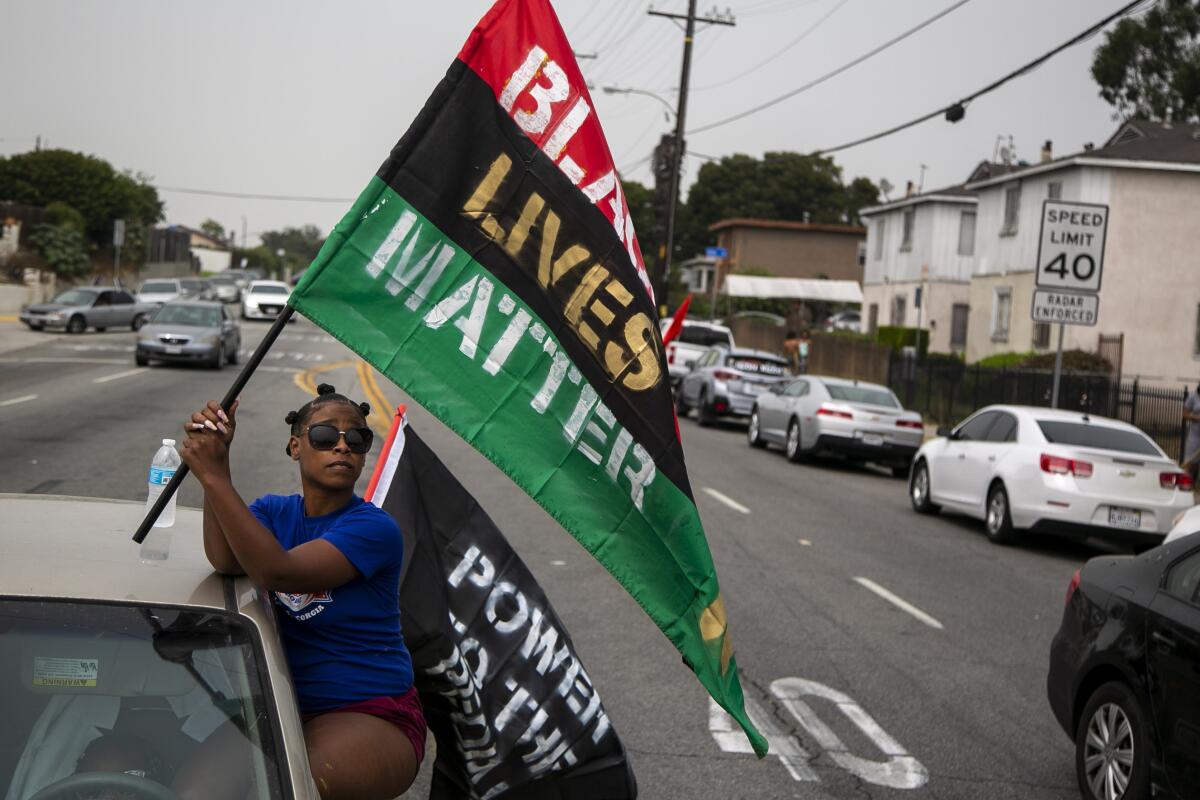
A recent Saturday protest brought hundreds to the residential street where Kizzee was killed before they marched to the sheriff’s station.
Deja Roquemore, 32, crouched in front of her house — across the street from the site of the shooting — to spray-paint “Black Lives Matter” on a black, red and green flag. She said that she’s taught her 6-year-old daughter not to fear the police, but this incident brought the fear back.
“I think they’ve made it seem the protesters are out for something else other than this life and Black lives,” Roquemore said of the Sheriff’s Department. “I love the camaraderie. I love the energy of togetherness. I love all of that, and that’s really what I’ve been seeing.”
That sense of unity has been important for Mike Ojo.
Ojo, 31, a professional basketball player in Japan who grew up in Ladera Heights, has spent the past few months photographing racial justice protests during his offseason.
He said that while walking with a friend to a recent Kizzee protest near the station, a sheriff’s vehicle pulled up next to them. Ojo said they were detained and handcuffed without explanation. After Ojo, who is Black, repeatedly asked why, he said he was told he fit the description of a suspect in the area allegedly carrying a gun.
Another sheriff’s vehicle arrived shortly after, and Ojo and his friend were forced into separate cars.
“I felt like I had my liberty violated by these people,” Ojo said. “It honestly kind of justified every bit of why I wanted to be out there. I am being accosted by the police for absolutely no reason other than being a Black man.”
They were released after about 10 minutes, left shaken. The officers, Ojo said, would not disclose their badge numbers — with several pretending not to hear his requests.
He continued toward the sheriff’s station and took photographs into the night, he said.
More to Read
Sign up for Essential California
The most important California stories and recommendations in your inbox every morning.
You may occasionally receive promotional content from the Los Angeles Times.
